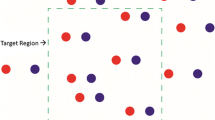Abstract
The two-dimensional (2D) and three-dimensional (3D) aperture problems are different forms of display in which moving stripes induce illusory perceptions of motion. From the viewpoint of visual psychology, this study applied a psychophysical method to determine the similarities and dissimilarities between the induced motion perceptions caused by the 2D and 3D aperture problems. The results indicate that for the 3D aperture problem, more time is required to induce motion perceptions than is required in the 2D aperture problem. The velocity thresholds of the 2D and 3D aperture problems also revealed that a certain velocity must be reached if induced motion perceptions are to occur, and the perceived motion in both cases appears to be toward the aperture edge that has the most terminal points. Generally, the 2D aperture problem is more effective at causing induced motion perception than the 3D aperture problem.
Access this chapter
Tax calculation will be finalised at checkout
Purchases are for personal use only
Similar content being viewed by others
References
Chen, C.H., Wu, W.H., Huang, K.C.: A study of lenticular printing used in military technology practices stereo photography. J. CAGST 2014, 28–58 (2014)
Fisher, N., Zanker, J.M.: The directional tuning of the barber-pole illusion. Perception 30, 1321–1336 (2001)
Wallach, H.: Uber visuell wahrgenommene Bewegungsrichtung. Psychol. Forsch. 20(1), 325–380 (1935)
Marr, D., Ullman, S.: Directional selectivity and its use in early visual processing. Proc. Roy. Soc. London B Biolog. Sci. 211(1183), 151–180 (1981)
Adelson, E.H., Movshon, J.A.: Phenomenal coherence of moving visual patterns. Nature 300(5892), 523–525 (1982)
Lorenceau, J., Shiffrar, M.: The influence of terminators on motion integration across space. Vision. Res. 32(2), 263–273 (1992)
Vallortigara, G., Bressan, P.: Occlusion and the perception of coherent motion. Vision. Res. 31(11), 1967–1978 (1991)
Chen, G.D., Lin, C.W., Fan, H.: Motion perception on column of rotational dynamic illusion in kinetic art. J. Des. 20(3), 1–19 (2015)
Chen, G.D.: The Study of Kinetic Art Dynamic Optical Illusion on Column with Spiral Pattern. National Taiwan Univ. of Science and Technology, Taipei (2008)
Guan, S.S.: Design Research Methods. Chuan Hwa Book Co. Ltd, New Taipei (2010)
Acknowledgement
This study was financially supported by the Research Grant MOST 103–2410-H-224–030 & MOST 104–2410-H-224–027- from Taiwan’s Ministry of Science and Technology.
Author information
Authors and Affiliations
Corresponding author
Editor information
Editors and Affiliations
Rights and permissions
Copyright information
© 2021 Springer Nature Switzerland AG
About this paper
Cite this paper
Chen, GD., Fan, H. (2021). Perceptions in Two-Dimensional and Three-Dimensional Aperture Problems. In: Stephanidis, C., Antona, M., Ntoa, S. (eds) HCI International 2021 - Late Breaking Posters. HCII 2021. Communications in Computer and Information Science, vol 1499. Springer, Cham. https://doi.org/10.1007/978-3-030-90179-0_67
Download citation
DOI: https://doi.org/10.1007/978-3-030-90179-0_67
Published:
Publisher Name: Springer, Cham
Print ISBN: 978-3-030-90178-3
Online ISBN: 978-3-030-90179-0
eBook Packages: Computer ScienceComputer Science (R0)




